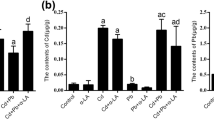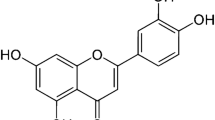Abstract
Lead (Pb) is a known toxic heavy metal which accumulates in different tissues and causes oxidative stress (OS) and inflammation. The brain tissue is considered as one of the most vulnerable organs to the Pb-induced toxicity. The aim of this study was to investigate the therapeutic effects of vitamin D3 (VD) supplementation against the damages caused by chronic Pb toxicity in the cerebral cortex. Forty Wistar rats were divided into four equal groups and were treated as follows: control group received no treatment, VD group received 1000 IU/kg of VD by intramuscular injection every other day, Pb group received 1000 mg/L of Pb in drinking water, and Pb + VD group received VD and Pb simultaneously. The experiment lasted for 4 weeks and the analyses were conducted 24 h after the last administrations. The obtained results demonstrated that Pb significantly increased cortical lipid peroxidation and reactive oxygen species (ROS) levels. At the same time, there was a significant reduction in glutathione (GSH) content, catalase (CAT), and superoxide dismutase (SOD) activities, as well as a significant increase in the tissue level of inflammatory cytokines. Furthermore, Pb increased the messenger RNA (mRNA) expression level of nuclear factor erythroid 2-related factor 2 (Nrf2) and nuclear factor-kappa B (NF-κB). Anyhow, VD administration during the period of Pb exposure suppressed the OS and inflammation by increasing the antioxidant molecules and decreasing the inflammatory cytokines and consequently repaired Pb-induced cortical tissue damages. Remarkably, these responses were concomitant with the alterations in Nrf2 and NF-κB gene expressions. In conclusion, the present study discloses the potential protective effects for VD against Pb-induced neurotoxicity via anti-inflammatory and antioxidative mechanisms.





Similar content being viewed by others
Change history
08 November 2022
A Correction to this paper has been published: https://doi.org/10.1007/s12640-022-00595-3
References
Abo El-Magd NF, Eraky SM (2020) The molecular mechanism underlining the preventive effect of vitamin D against hepatic and renal acute toxicity through the NrF2/ BACH1/ HO-1 pathway. Life Sci 244:117331. https://doi.org/10.1016/j.lfs.2020.117331
Aglan HS, Gebremedhn S, Salilew-Wondim D, Neuhof C, Tholen E et al (2020) Regulation of Nrf2 and NF-κB during lead toxicity in bovine granulosa cells. Cell Tissue Res 380:643–655. https://doi.org/10.1007/s00441-020-03177-x
Almaimani RA, Almasmoum H, Ghaith MM, El-Boshy M, Idris S et al (2019) Enhanced remedial effects for vitamin D3 and calcium co-supplementation against pre-existing lead nephrotoxicity in mice: the roles of renal calcium homeostatic molecules. Biochim Biophys Acta - Mol Basis Dis 1865:512–524. https://doi.org/10.1016/j.bbadis.2018.11.023
Anjum I, Jaffery SS, Fayyaz M, Samoo Z, Anjum S et al (2018) The role of vitamin D in brain health: a mini literature review. Cureus. https://doi.org/10.7759/cureus.2960
Annweiler C (2016) Vitamin D in dementia prevention. Ann N Y Acad Sci 1367:57–63. https://doi.org/10.1111/nyas.13058
BaSalamah MA, Abdelghany AH, El-Boshy M, Ahmad J, Idris S et al (2018) Vitamin D alleviates lead induced renal and testicular injuries by immunomodulatory and antioxidant mechanisms in rats. Sci Rep 8:4853. https://doi.org/10.1038/s41598-018-23258-w
Bijoor AR, Sudha S, Venkatesh T et al (2012) Neurochemical and neurobehavioral effects of low lead exposure on the developing brain. Indian J Clin Biochem 27:147–151. https://doi.org/10.1007/s12291-012-0190-2
Broniowska Ż, Bystrowska B, Starek-Świechowicz B, Pomierny B, Krzyżanowska W et al (2019) Benzophenone-2 concentration and its effect on oxidative stress and apoptosis markers in rat brain. Neurotox Res 36:39–48. https://doi.org/10.1007/s12640-019-0011-y
Buell JS, Scott TM, Dawson-Hughes B, Dallal GE, Rosenberg IH et al (2009) Vitamin D is associated with cognitive function in elders receiving home health services. Journals Gerontol Ser A Biol Sci Med Sci 64A:888–895. https://doi.org/10.1093/gerona/glp032
Chang L, Liu X, Shi H, Dai W, Wang H et al (2014) Association of 25-hydroxyvitamin D with Hb and lead in children: a Chinese population-based study. Public Health Nutr 17:827–832. https://doi.org/10.1017/S1368980013001675
Chen Y, Zhang J, Ge X, Du J, Deb DK et al (2013) Vitamin D receptor inhibits nuclear factor κB activation by interacting with IκB kinase β protein. J Biol Chem 288:19450–19458. https://doi.org/10.1074/jbc.M113.467670
Chibowska K, Baranowska-Bosiacka I, Falkowska A, Gutowska I, Goschorska M et al (2016) Effect of lead (Pb) on inflammatory processes in the brain. Int J Mol Sci 17:2140. https://doi.org/10.3390/ijms17122140
Chibowska K, Korbecki J, Gutowska I, Metryka E, Tarnowski M et al (2020) Pre- and neonatal exposure to lead (Pb) induces neuroinflammation in the forebrain cortex, hippocampus and cerebellum of rat pups. Int J Mol Sci 21:1083. https://doi.org/10.3390/ijms21031083
Cohen-Lahav M, Shany S, Tobvin D, Chaimovitz C, Douvdevani A et al (2006) Vitamin D decreases NFκB activity by increasing IκBα levels. Nephrol Dial Transplant 21:889–897. https://doi.org/10.1093/ndt/gfi254
DeLuca GC, Kimball SM, Kolasinski J, Ramagopalan SV, Ebers GC et al (2013) Review: the role of vitamin D in nervous system health and disease. Neuropathol Appl Neurobiol 39:458–484. https://doi.org/10.1111/nan.12020
Dongre NN, Suryakar AN, Patil AJ, Hundekari IA, Devarnavadagi BB et al (2013) Biochemical effects of lead exposure on battery manufacture workers with reference to blood pressure, calcium metabolism and bone mineral density. Indian J Clin Biochem 28:65–70. https://doi.org/10.1007/s12291-012-0241-8
Eyles DW, Smith S, Kinobe R, Hewison M, McGrath JJ et al (2005) Distribution of the vitamin D receptor and 1α-hydroxylase in human brain. J Chem Neuroanat 29:21–30. https://doi.org/10.1016/j.jchemneu.2004.08.006
Flora G, Gupta D, Tiwari A et al (2012) Toxicity of lead: a review with recent updates. Interdiscip Toxicol 5:47–58. https://doi.org/10.2478/v10102-012-0009-2
Gandhi S, Abramov AY (2012) Mechanism of oxidative stress in neurodegeneration. Oxid Med Cell Longev 2012:1–11. https://doi.org/10.1155/2012/428010
Gargouri M, Hamed H, Akrouti A, Christian M, Ksouri R et al (2017) Immunomodulatory and antioxidant protective effect of Sarcocornia perennis L. (swampfire) in lead intoxicated rat. Toxicol Mech Methods 27:697–706. https://doi.org/10.1080/15376516.2017.1351018
Hayden MS, Ghosh S (2014) Regulation of NF-κB by TNF family cytokines. Semin Immunol 26:253–266. https://doi.org/10.1016/j.smim.2014.05.004
Hosseinirad H, Novin MG, Hosseini S, Nazarian H, Amidi F et al (2020) Effect of 1,25(OH)2-vitamin D3 on expression and phosphorylation of progesterone receptor in cultured endometrial stromal cells of patients with repeated implantation failure. Acta Histochem 122:151489. https://doi.org/10.1016/j.acthis.2019.151489
Lidsky TI, Schneider JS (2003) Lead neurotoxicity in children: basic mechanisms and clinical correlates. Brain 126:5–19. https://doi.org/10.1093/brain/awg014
Lim J, Ortiz L, Nakamura BN, Hoang YD, Banuelos J et al (2015) Effects of deletion of the transcription factor Nrf2 and benzo [a]pyrene treatment on ovarian follicles and ovarian surface epithelial cells in mice. Reprod Toxicol 58:24–32. https://doi.org/10.1016/j.reprotox.2015.07.080
Liu K, Hao J, Zeng Y, Dai F, Gu P et al (2013) Neurotoxicity and biomarkers of lead exposure: a review. Chinese Med Sci J 28:178–188. https://doi.org/10.1016/S1001-9294(13)60045-0
Long M, Liu Y, Cao Y, Wang N, Dang M et al (2016) Proanthocyanidins attenuation of chronic lead-induced liver oxidative damage in Kunming mice via the Nrf2/ARE pathway. Nutrients 8:656. https://doi.org/10.3390/nu8100656
Lu J, Jiang H, Liu B, Baiyun R, Li S et al (2018) Grape seed procyanidin extract protects against Pb-induced lung toxicity by activating the AMPK/Nrf2/p62 signaling axis. Food Chem Toxicol 116:59–69. https://doi.org/10.1016/j.fct.2018.03.034
Manoj Kumar V, Henley AK, Nelson CJ, Indumati O, Prabhakara Rao Y et al (2017) Protective effect of Allium sativum (garlic) aqueous extract against lead-induced oxidative stress in the rat brain, liver, and kidney. Environ Sci Pollut Res 24:1544–1552. https://doi.org/10.1007/s11356-016-7923-3
Nachliely M, Trachtenberg A, Khalfin B, Nalbandyan K, Cohen-Lahav M et al (2019) Dimethyl fumarate and vitamin D derivatives cooperatively enhance VDR and Nrf2 signaling in differentiating AML cells in vitro and inhibit leukemia progression in a xenograft mouse model. J Steroid Biochem Mol Biol 188:8–16. https://doi.org/10.1016/j.jsbmb.2018.11.017
Nakai K, Fujii H, Kono K, Goto S, Kitazawa R et al (2014) Vitamin D activates the Nrf2-Keap1 antioxidant pathway and ameliorates nephropathy in diabetic rats. Am J Hypertens 27:586–595. https://doi.org/10.1093/ajh/hpt160
Patel M (2016) Targeting oxidative stress in central nervous system disorders. Trends Pharmacol Sci 37:768–778. https://doi.org/10.1016/j.tips.2016.06.007
Rahman A, Al-Awadi AA, Khan KM et al (2018) Lead affects vitamin D metabolism in rats. Nutrients 10:1–17. https://doi.org/10.3390/nu10030264
Rath E, Haller D (2011) Inflammation and cellular stress: a mechanistic link between immune-mediated and metabolically driven pathologies. Eur J Nutr 50:219–233. https://doi.org/10.1007/s00394-011-0197-0
Saad El-Din S, Rashed L, Medhat E, Emad Aboulhoda B, Desoky Badawy A et al (2020) Active form of vitamin D analogue mitigates neurodegenerative changes in Alzheimer’s disease in rats by targeting Keap1/Nrf2 and MAPK-38p/ERK signaling pathways. Steroids 156:108586. https://doi.org/10.1016/j.steroids.2020.108586
Sanders T, Liu Y, Buchner V, Tchounwou PB et al (2009) Neurotoxic Effects and Biomarkers of Lead Exposure: A Review. Rev Environ Health 24:15–45. https://doi.org/10.1515/REVEH.2009.24.1.15
Tao S, Zhang H, Xue L, Jiang X, Wang H et al (2019) Vitamin D protects against particles-caused lung injury through induction of autophagy in an Nrf2-dependent manner. Environ Toxicol 34:594–609. https://doi.org/10.1002/tox.22726
Wang Y, Zhang C, Peng W, Xia Z, Gan P et al (2016) Hydroxysafflor yellow A exerts antioxidant effects in a rat model of traumatic brain injury. Mol Med Rep 14:3690–3696. https://doi.org/10.3892/mmr.2016.5720
Wardyn JD, Ponsford AH, Sanderson CM et al (2015) Dissecting molecular cross-talk between Nrf2 and NF-κB response pathways. Biochem Soc Trans 43:621–626. https://doi.org/10.1042/BST20150014
Yousef AOS, Fahad AA, Moneim AEA, Metwally DM, El-Khadragy MF et al (2019) The neuroprotective role of coenzyme Q10 against lead acetate-induced neurotoxicity is mediated by antioxidant, anti-inflammatory and anti-apoptotic activities. Int J Environ Res Public Health 16:1–17. https://doi.org/10.3390/ijerph16162895
Zachariadis GA, Stratis JA, Kaniou I, Kalligas G et al (1995) Critical comparison of wet and dry digestion procedures for trace metal analysis of meat and fish tissues. Mikrochim Acta 119:191–198. https://doi.org/10.1007/BF01243998
Zhang M, An C, Gao Y, Leak RK, Chen J et al (2013) Emerging roles of Nrf2 and phase II antioxidant enzymes in neuroprotection. Prog Neurobiol 100:30–47. https://doi.org/10.1016/j.pneurobio.2012.09.003
Acknowledgements
The authors would like to thank the Research Council of Baqiyatallah University of Medical Sciences for their kind assistance.
Author information
Authors and Affiliations
Corresponding author
Ethics declarations
Conflict of Interest
The authors declare that they have no conflict of interest.
Ethics Approval
The study was approved by the Ethics Committee of Baqiyatallah University of Medical Sciences, Tehran, Iran (IR.BMSU.REC.1398.223) which is in accordance with “The Guide for the Care and Use of Laboratory Animals”.
Additional information
Publisher’s Note
Springer Nature remains neutral with regard to jurisdictional claims in published maps and institutional affiliations.
Rights and permissions
Springer Nature or its licensor (e.g. a society or other partner) holds exclusive rights to this article under a publishing agreement with the author(s) or other rightsholder(s); author self-archiving of the accepted manuscript version of this article is solely governed by the terms of such publishing agreement and applicable law.
About this article
Cite this article
Hoseinrad , H., Shahrestanaki, J.K., Moosazadeh Moghaddam, M. et al. Protective Effect of Vitamin D3 Against Pb-Induced Neurotoxicity by Regulating the Nrf2 and NF-κB Pathways. Neurotox Res 39, 687–696 (2021). https://doi.org/10.1007/s12640-020-00322-w
Received:
Revised:
Accepted:
Published:
Issue Date:
DOI: https://doi.org/10.1007/s12640-020-00322-w




